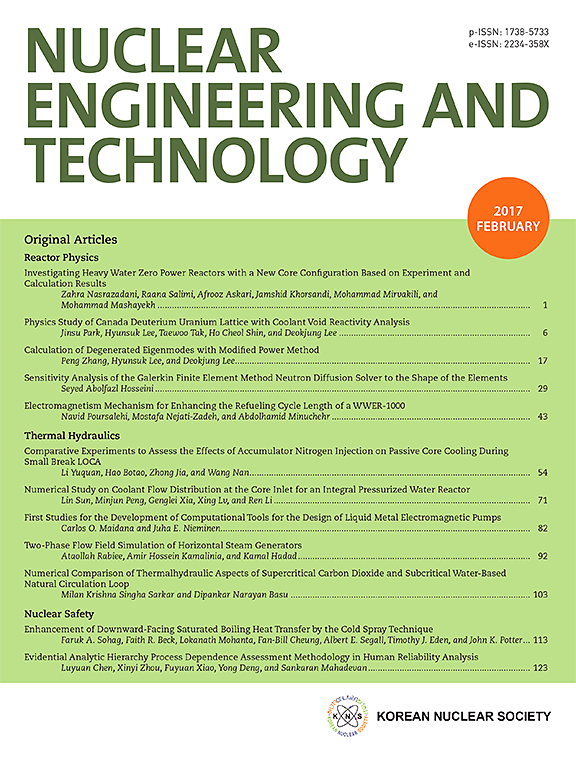通过 GTA 和激光熔覆工艺对 316L(N) SS 与 Ni-Cr-B-Si 合金硬面的拉伸和高循环疲劳行为进行比较研究
IF 2.6
3区 工程技术
Q1 NUCLEAR SCIENCE & TECHNOLOGY
引用次数: 0
摘要
在钠冷快堆 (SFR) 中,316L(N) SS 格栅板采用 Ni-Cr-B-Si 合金硬面处理,以获得更高的耐磨性。由于两种材料的热膨胀系数不同,拉伸力和疲劳力作用在基体和沉积物的界面上,可能导致沉积物开裂,并在运行过程中断裂。因此,考虑采用适当的硬面堆焊方法非常重要,这种方法可以提供更高的抗拉强度和疲劳强度,以避免界面开裂/脱粘。为了解决这个问题,我们考虑了两种硬面堆焊技术,即气体钨弧焊(GTA)和激光熔覆(LC)。每种工艺都制备了硬面试样,并对其进行了拉伸和高循环疲劳测试。通过实验测试生成应力-应变和 S-N 曲线,以预测试样的拉伸和疲劳性能。对断裂表面进行了断面研究,以了解疲劳裂纹的成核和扩展特征。对两个过程的实验结果进行了比较。由于脆性较高,LC 试样的拉伸强度和疲劳强度分别比 GTA 试样低 11 % 和 17 %。因此,建议将 GTA 工艺作为 SFR 网格板的有效硬面处理工艺。本文章由计算机程序翻译,如有差异,请以英文原文为准。
Comparative study on tensile and high cycle fatigue behaviour of 316L(N) SS hardfaced with Ni-Cr-B-Si alloy by GTA and laser cladding processes
In sodium-cooled fast reactors (SFR), 316L(N) SS grid plate is hardfaced with Ni-Cr-B-Si alloy to achieve higher wear resistance. Tensile and fatigue forces are acting at the interface between substrate and deposit due to different thermal expansion coefficients of those two materials, which can cause cracking of deposit and fracture during operation. Thus, it is very important to consider appropriate hardfacing method which can provide higher tensile and fatigue strength to avoid cracking/debonding at the interface. To find a solution to this problem, two hardfacing techniques, namely Gas Tungsten Arc (GTA) and Laser cladding (LC), are taken into consideration. Hardfaced specimens are prepared using each process on which tensile and high cycle fatigue tests are conducted. From the experimental testing, stress-strain and S-N curves are generated to predict the tensile and fatigue behaviour of specimens. Fractographic studies are conducted at fractured surfaces to understand the fatigue crack nucleation and propagation characteristics. The experimental results for both processes are compared. Tensile and fatigue strength of LC specimens are ∼11 % and ∼17 % less than those of GTA specimens due to its higher brittleness. Thus, GTA process is recommended as the efficient hardfacing process for grid plate of SFR.
求助全文
通过发布文献求助,成功后即可免费获取论文全文。
去求助
来源期刊

Nuclear Engineering and Technology
工程技术-核科学技术
CiteScore
4.80
自引率
7.40%
发文量
431
审稿时长
3.5 months
期刊介绍:
Nuclear Engineering and Technology (NET), an international journal of the Korean Nuclear Society (KNS), publishes peer-reviewed papers on original research, ideas and developments in all areas of the field of nuclear science and technology. NET bimonthly publishes original articles, reviews, and technical notes. The journal is listed in the Science Citation Index Expanded (SCIE) of Thomson Reuters.
NET covers all fields for peaceful utilization of nuclear energy and radiation as follows:
1) Reactor Physics
2) Thermal Hydraulics
3) Nuclear Safety
4) Nuclear I&C
5) Nuclear Physics, Fusion, and Laser Technology
6) Nuclear Fuel Cycle and Radioactive Waste Management
7) Nuclear Fuel and Reactor Materials
8) Radiation Application
9) Radiation Protection
10) Nuclear Structural Analysis and Plant Management & Maintenance
11) Nuclear Policy, Economics, and Human Resource Development
 求助内容:
求助内容: 应助结果提醒方式:
应助结果提醒方式:


